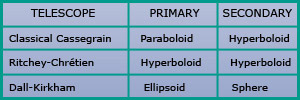The Corrected Dall-Kirkham (CDK)
The Cassegrain reflector is a two-mirror telescope design invented by Laurent Cassegrain in 1672. A 'classical' Cassegrain telescope has a parabolic primary mirror and a hyperboloidal secondary mirror. There are numerous variations of the basic Cassegrain design, the main difference between them being the shape of the surfaces on the mirrors:

The Ritchey-Chrétien (RC) is the best known and most respected of the Cassegrain reflector variants and is used extensively in professional telescopes. However, because both mirrors are hyperbolic, an RC telescope is very difficult to fabricate. Furthermore, their collimation must be precise if the telescope's design potential is to be realized. The precise collimation required is often difficult to achieve in practice, especially if one is using a large format CCD detector.
The Dall-Kirkham, with it's elliptical primary and spherical secondary mirror, is an easier-to-fabricate version of the Cassegrain reflector. However, although a Dall-Kirkham produces a perfect image on-axis, very bad coma off-axis severely restricts the field of view. The field-corrected Dall-Kirkham, or CDK, uses at least two lenses ahead of the focal plane to correct off-axis aberrations, including field curvature and astigmatism. During the optical design process, the CDK's secondary is kept spherical, but the asphericity of the primary mirror and the shapes of the lenses are allowed to vary in order to balance all aberrations at the focal plane. As such, the CDK must be used with the field corrector lens group in place; the two mirrors alone will not form a usable image.
The CDK's field corrector groups can take on a variety of shapes, but they must have at least two lenses to be effective at correcting aberrations. More advanced designs for faster systems, or for covering a very wide field, may require three or more lenses. These design considerations dictated that both the f/4.9 and f/9 field corrector groups for the Ceravolo 300 Astrograph contain three elements. Image quality is not the only objective when designing CDK optics; just as important is the elimination of ghost images that can arise from spurious reflections off the CCD and lens surfaces.